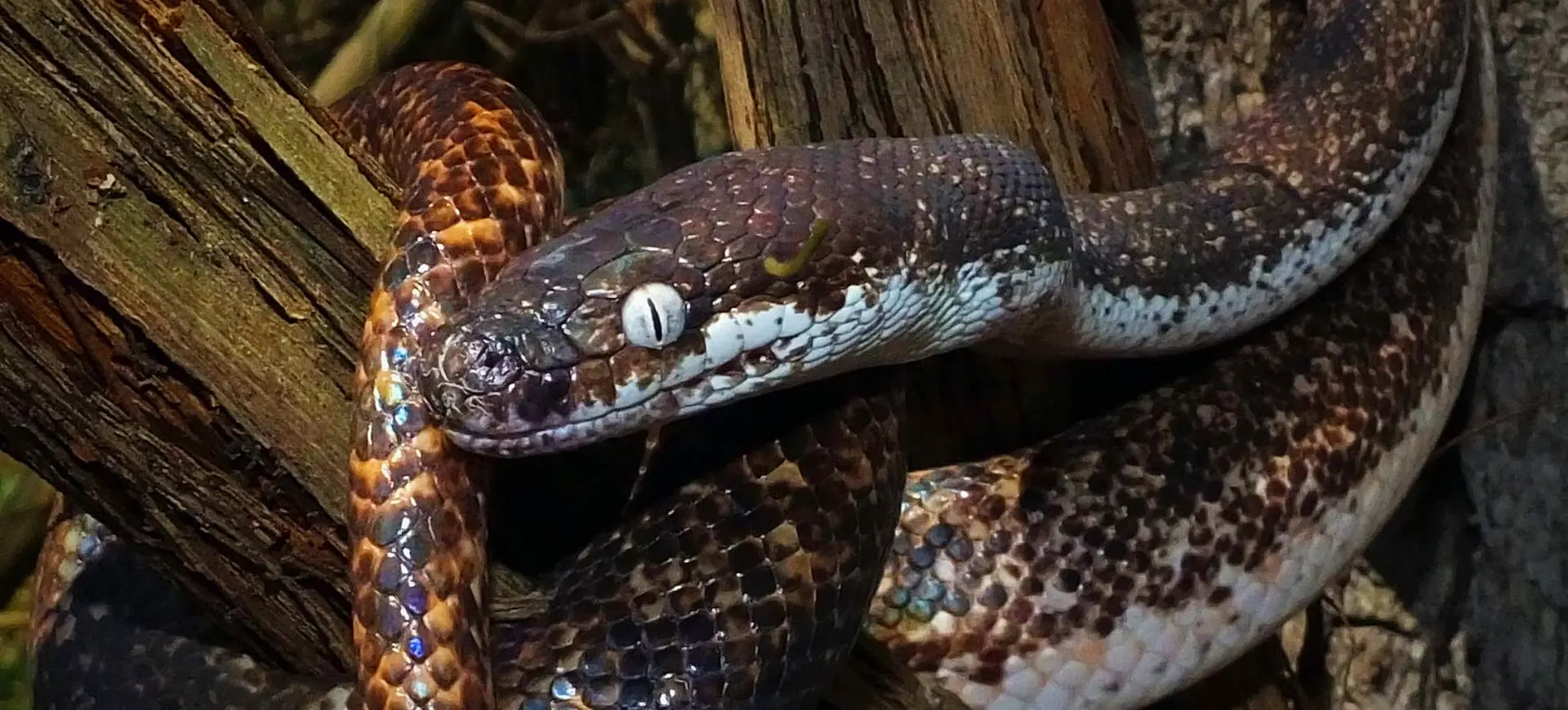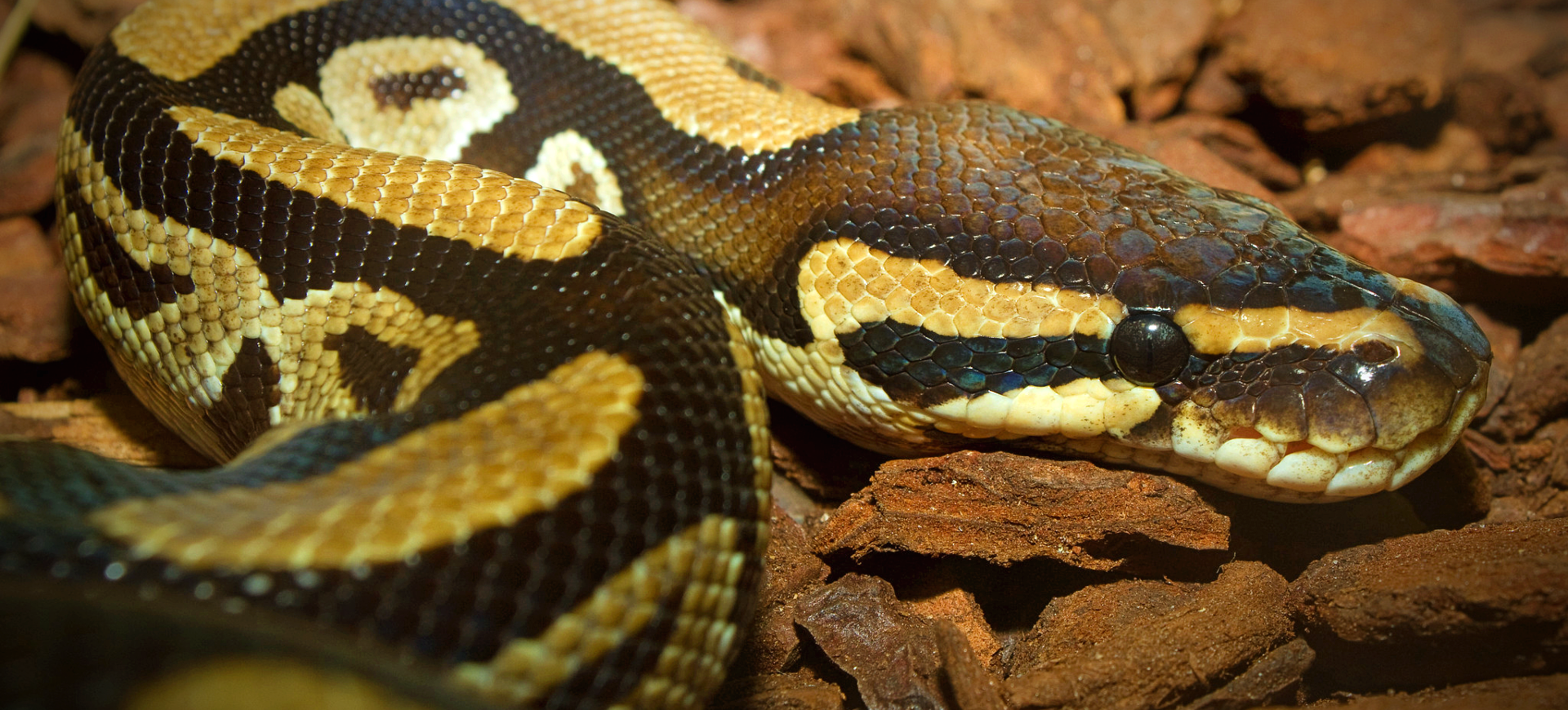Overview
The Burmese Python, scientifically named Python bivittatus, is one of the largest species of snakes in the world, native to a broad region in Southeast Asia. This python is known for its striking pattern of dark brown blotches outlined in black against a tan or yellowish background. Adult Burmese Pythons typically range from 12 to 16 feet (3.7 to 4.9 meters) in length, with some individuals growing even larger. They are heavy-bodied snakes, with females generally larger and heavier than males.
Burmese Pythons are semi-aquatic and often found near water. They are excellent swimmers and can be found in various habitats, including grasslands, marshes, swamps, and rocky foothills. They are primarily nocturnal and rely on their camouflage and stealth for hunting. Their diet consists mainly of small mammals and birds, which they kill by constriction. The Burmese Python is an invasive species in some areas outside its native range, particularly in the Florida Everglades, where it poses a significant threat to local wildlife.
The species is oviparous, laying a clutch of eggs that the female incubates by coiling around them and generating heat through muscular contractions. These pythons have a significant cultural and economic impact in their native range, used in the pet trade, traditional medicine, and food. However, they face threats from habitat loss and are hunted for their skin, meat, and use in traditional medicine.
Taxonomy
Kingdom
Phylum
Class
Order
Family
Genus
Species
Type
Current distribution:
The Burmese Python is widely distributed across Southeast Asia, including countries like Myanmar (Burma), Thailand, Laos, Vietnam, Cambodia, and parts of Indonesia. In recent years, the species has become an invasive problem in the Florida Everglades in the United States, likely due to the release or escape of pet snakes. In these non-native areas, they have adapted well to the local environment but pose a significant ecological threat to native species.
Conservation efforts for the Burmese Python in its native range focus on habitat protection and mitigating human-wildlife conflict. In non-native regions like Florida, management efforts are geared towards controlling and reducing their populations to protect local ecosystems. Research into their ecology and impact on native species is ongoing to inform conservation and management strategies.
Physical Description:
The Burmese Python is notable for its impressive size and distinct pattern. The snake’s body is covered in dark brown or black blotches and rosettes, edged in black, on a tan, yellow, or light brown background. This patterning provides excellent camouflage in their natural habitat. Adults typically reach lengths of 12 to 16 feet (3.7 to 4.9 meters), though some individuals have been recorded at over 20 feet (6 meters) long.
The snake has a broad, triangular head with many heat-sensing pits along the upper and lower jaws, adaptations for detecting warm-blooded prey in low-light conditions. The eyes are small with vertical pupils, and the body is muscular, well-suited for its constricting hunting method. Females are generally larger than males in length and girth, a common trait among many python species. The size and pattern of the Burmese Python make it one of the most recognizable and formidable constrictors in its native range.

Lifespan: Wild: ~25 Years || Captivity: ~30 Years

Weight: Male: 11-40 lbs (5-18 kg) || Female: 20-200 lbs (9-90 kg)

Length: Male: 96-144 in (244-366 cm) || Female: 144-216 in (366-549 cm)

Top Speed: 1 mph (1.6 km/h)
Characteristic:
Native Habitat:
The Burmese Python is native to a wide range of Southeast Asia, including grasslands, marshes, swamps, and rocky foothills. They are adaptable to various habitats but are most commonly associated with areas near water. Their semi-aquatic nature makes them proficient swimmers, capable of staying submerged for extended periods. The Burmese Python thrives in tropical and subtropical environments, often close to human settlements.
In their natural habitat, these pythons often utilize burrows made by small mammals, holes in trees, or dense vegetation as hiding places. The loss of natural habitats due to human expansion and agricultural development threatens their populations in the wild. Conservation of these habitats is crucial for the species’ survival in its native range.
Biomes:
Biogeographical Realms:
Continents:
Diet:
Diet & Feeding Habits:
The Burmese Python is a carnivorous predator that primarily feeds on various mammals and birds. In its natural habitat, it preys on rodents, small to medium-sized mammals, and birds, which it ambushes and then kills by constriction. They have slow metabolisms and can survive for extended periods without food after consuming a large prey item.
In captivity, the diet of the Burmese Python includes pre-killed or live rodents, rabbits, and poultry, depending on the snake’s size. Feeding frequency varies with age, size, and reproductive status, with juveniles eating more frequently than adults. Proper nutrition is essential for their growth and health. Invasive populations, such as those in Florida, pose a significant threat to native wildlife, preying on a wide range of native species.
Mating Behavior:
Mating Description:
The Burmese Python’s mating season typically occurs in the spring. Males locate females through pheromone trails and may engage in combat with other males to win mating rights. The mating process involves the male coiling around the female and aligning their cloacae for copulation. Females are oviparous, laying a clutch of eggs several weeks after mating.
After laying her eggs, the female python exhibits maternal care by coiling around the eggs to protect them and regulate their temperature through muscular shivering. This behavior increases the temperature of the eggs, promoting healthy development. The incubation lasts about two months, after which the eggs hatch, and the young are independent from birth. Protecting the nesting sites of Burmese Pythons is crucial in their native habitats to ensure successful reproduction.
Reproduction Season:
Birth Type:
Pregnancy Duration:
Female Name:
Male Name:
Baby Name:
Social Structure Description:
The Burmese Python is largely solitary, with individuals typically interacting only during the mating season. They are territorial and may exhibit aggressive behavior when threatened. Understanding the social behavior of the Burmese Python is important for its management, particularly in captive settings where interactions with other individuals may occur.
In the wild, their solitary nature is reflected in their hunting and nesting habits, with each individual occupying its territory. Care must be taken in captivity to provide adequate space and environmental enrichment to mimic their natural lifestyle and reduce stress. Studying their social behavior in wild and captive settings can provide insights into their ecological needs and natural behaviors.
Groups:
Conservation Status:
Population Trend:
The Burmese Python is classified as Vulnerable in its native range, primarily due to habitat loss and hunting for their skins and meat. The population trend in Southeast Asia is decreasing, with these pythons facing ongoing threats from human activities. In contrast, the invasive population in the Florida Everglades is increasing and poses a significant ecological threat.
Conservation efforts in their native habitat focus on habitat protection and reducing hunting pressure. Sustainable land use practices and habitat restoration are key to conserving the species in the wild. In their invasive range, efforts are concentrated on population control to mitigate their impact on local ecosystems. Public education and responsible pet ownership are also crucial to prevent future invasions.
Population Threats:
The primary threats to the Burmese Python in its native range include habitat destruction due to deforestation, agricultural expansion, and hunting for their skins, meat, and use in traditional medicine. These activities lead to decreased suitable habitats and reduced population numbers. In their invasive range, they threaten native wildlife, competing with native predators and prey on various native species.
Efforts to mitigate these threats include enforcing wildlife protection laws, promoting sustainable land use practices, and controlling illegal wildlife trade. In non-native regions, management strategies involve population control measures, research into their ecological impact, and public awareness campaigns to prevent pet releases. Collaborative efforts involving local communities, governments, and conservation organizations are essential for effectively conserving and managing the Burmese Python.
Conservation Efforts:
Conservation efforts for the Burmese Python in its native range focus on protecting and restoring their natural habitats. This includes establishing protected areas, enforcing hunting regulations, and promoting sustainable forestry and agricultural practices. In their invasive range, efforts are aimed at controlling their population to protect local ecosystems, including removal programs and public education on the ecological dangers of releasing pet snakes into the wild.
Research is critical in these conservation efforts, providing valuable information on the species’ ecology, behavior, and habitat needs. Understanding the impact of human activities and developing effective management strategies are key to conserving the Burmese Python in its native habitat and controlling its population in non-native areas. International collaboration is crucial, given their range’s transboundary nature and the pet trade’s global scale.
Additional Resources:
Fun Facts
- The Burmese Python is one of the largest snake species in the world, capable of reaching impressive lengths.
- They are known for their distinctive pattern, which provides excellent camouflage in their natural habitat.
- In their native range, the Burmese Python is revered in some cultures and featured in mythology and folklore.
- Flexible jaws and a robust muscular body facilitate their ability to consume large prey items.
- Invasive populations of Burmese Pythons, such as those in Florida, have adapted well to new environments but pose a significant ecological threat.
- They exhibit maternal care, a relatively rare behavior among snakes, by incubating their eggs until hatching.
- The Burmese Python’s status as a popular pet has contributed to its invasive spread in non-native areas.
- Conservation of this species in its native range is challenged by habitat loss and hunting pressures.
- They play an important role in their ecosystem as both predators and prey.
- Efforts to manage their populations in invasive areas include removal programs and public education about the risks of releasing pet snakes into the wild.














